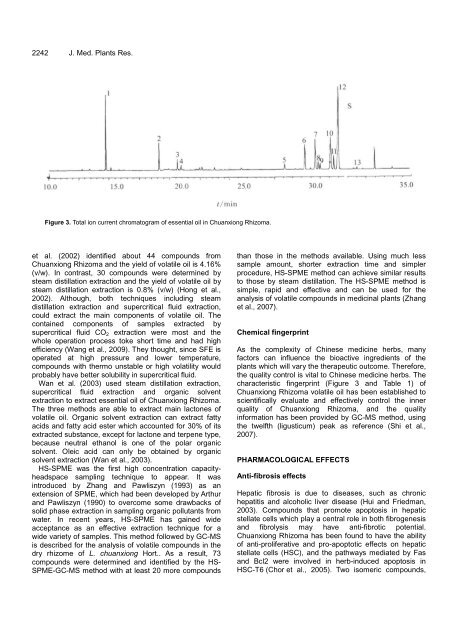Download Complete Issue - Academic Journals
Download Complete Issue - Academic Journals
Download Complete Issue - Academic Journals
Create successful ePaper yourself
Turn your PDF publications into a flip-book with our unique Google optimized e-Paper software.
2242 J. Med. Plants Res.<br />
Figure 3. Total ion current chromatogram of essential oil in Chuanxiong Rhizoma.<br />
et al. (2002) identified about 44 compounds from<br />
Chuanxiong Rhizoma and the yield of volatile oil is 4.16%<br />
(v/w). In contrast, 30 compounds were determined by<br />
steam distillation extraction and the yield of volatile oil by<br />
steam distillation extraction is 0.8% (v/w) (Hong et al.,<br />
2002). Although, both techniques including steam<br />
distillation extraction and supercritical fluid extraction,<br />
could extract the main components of volatile oil. The<br />
contained components of samples extracted by<br />
supercritical fluid CO2 extraction were most and the<br />
whole operation process toke short time and had high<br />
efficiency (Wang et al., 2009). They thought, since SFE is<br />
operated at high pressure and lower temperature,<br />
compounds with thermo unstable or high volatility would<br />
probably have better solubility in supercritical fluid.<br />
Wan et al. (2003) used steam distillation extraction,<br />
supercritical fluid extraction and organic solvent<br />
extraction to extract essential oil of Chuanxiong Rhizoma.<br />
The three methods are able to extract main lactones of<br />
volatile oil. Organic solvent extraction can extract fatty<br />
acids and fatty acid ester which accounted for 30% of its<br />
extracted substance, except for lactone and terpene type,<br />
because neutral ethanol is one of the polar organic<br />
solvent. Oleic acid can only be obtained by organic<br />
solvent extraction (Wan et al., 2003).<br />
HS-SPME was the first high concentration capacityheadspace<br />
sampling technique to appear. It was<br />
introduced by Zhang and Pawliszyn (1993) as an<br />
extension of SPME, which had been developed by Arthur<br />
and Pawliszyn (1990) to overcome some drawbacks of<br />
solid phase extraction in sampling organic pollutants from<br />
water. In recent years, HS-SPME has gained wide<br />
acceptance as an effective extraction technique for a<br />
wide variety of samples. This method followed by GC-MS<br />
is described for the analysis of volatile compounds in the<br />
dry rhizome of L. chuanxiong Hort.. As a result, 73<br />
compounds were determined and identified by the HS-<br />
SPME-GC-MS method with at least 20 more compounds<br />
than those in the methods available. Using much less<br />
sample amount, shorter extraction time and simpler<br />
procedure, HS-SPME method can achieve similar results<br />
to those by steam distillation. The HS-SPME method is<br />
simple, rapid and effective and can be used for the<br />
analysis of volatile compounds in medicinal plants (Zhang<br />
et al., 2007).<br />
Chemical fingerprint<br />
As the complexity of Chinese medicine herbs, many<br />
factors can influence the bioactive ingredients of the<br />
plants which will vary the therapeutic outcome. Therefore,<br />
the quality control is vital to Chinese medicine herbs. The<br />
characteristic fingerprint (Figure 3 and Table 1) of<br />
Chuanxiong Rhizoma volatile oil has been established to<br />
scientifically evaluate and effectively control the inner<br />
quality of Chuanxiong Rhizoma, and the quality<br />
information has been provided by GC-MS method, using<br />
the twelfth (ligusticum) peak as reference (Shi et al.,<br />
2007).<br />
PHARMACOLOGICAL EFFECTS<br />
Anti-fibrosis effects<br />
Hepatic fibrosis is due to diseases, such as chronic<br />
hepatitis and alcoholic liver disease (Hui and Friedman,<br />
2003). Compounds that promote apoptosis in hepatic<br />
stellate cells which play a central role in both fibrogenesis<br />
and fibrolysis may have anti-fibrotic potential.<br />
Chuanxiong Rhizoma has been found to have the ability<br />
of anti-proliferative and pro-apoptotic effects on hepatic<br />
stellate cells (HSC), and the pathways mediated by Fas<br />
and Bcl2 were involved in herb-induced apoptosis in<br />
HSC-T6 (Chor et al., 2005). Two isomeric compounds,

















